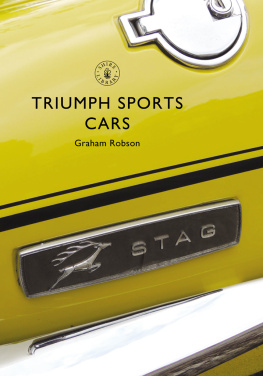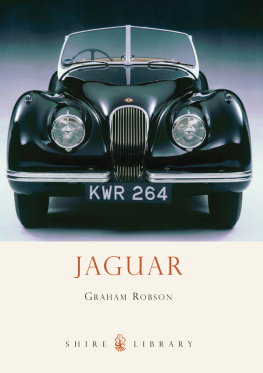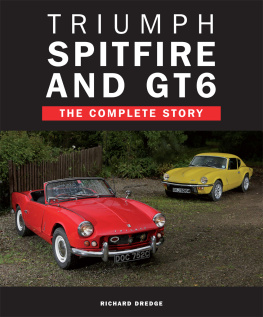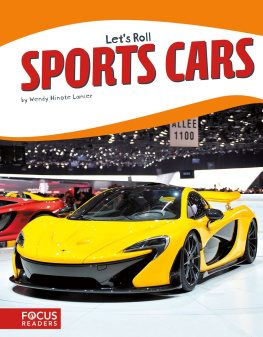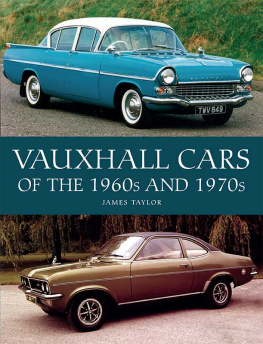
Published in Great Britain in 2017 by Shire Publications Ltd (part of Bloomsbury Publishing Plc), PO Box 883, Oxford, OX1 9PL, UK.
1385 Broadway, 5th Floor New York, NY 10018, USA.
E-mail:
www.shirebooks.co.uk
This electronic edition published in 2017 by Bloomsbury Publishing Plc
2017 Graham Robson.
All rights reserved
You may not copy, distribute, transmit, reproduce or otherwise make available this publication (or any part of it) in any form, or by any means (including without limitation electronic, digital, optical, mechanical, photocopying, printing, recording or otherwise), without the prior written permission of the publisher. Any person who does any unauthorised act in relation to this publication may be liable to criminal prosecution and civil claims for damages.
Every attempt has been made by the Publishers to secure the appropriate permissions for materials reproduced in this book. If there has been any oversight we will be happy to rectify the situation and a written submission should be made to the Publishers.
A CIP catalogue record for this book is available from the British Library.
Shire Library no. 827. ISBN: 978-1-78442-041-3 (PB)
ISBN: 978-1-78442-106-9 (ePDF)
ISBN: 978-1-78442-105-2 (eBook)
Graham Robson has asserted his right under the Copyright, Designs and Patents Act, 1988, to be identified as the author of this book.
COVER IMAGE
Detail of a TR7. (Courtesy of Andrew Gribben)
TITLE PAGE IMAGE
A publicity image of a TR3A in Paris.
CONTENTS PAGE IMAGE
The TR6 was the last of the separate-chassis TRs, and had the characteristic cut-off tail style of all Triumph sports cars of the period. Well over 100,000 such machines were sold.
ACKNOWLEDGEMENTS
Most of the images in this book are from the Bill Piggott collection. The exceptions are as follows: Alamy, pages
Shire Publications is supporting the Woodland Trust, the UKs leading woodland conservation charity, by funding the dedication of trees.

CONTENTS
TRIUMPH THE FIRST DECADES
ALTHOUGH BEFORE THE Second World War there were many famous Triumphs Glorias, Vitesses, Southern Crosses and Dolomites which sold in modest numbers, it wasnt until the TR2 came along that the marque truly prospered. Triumphs story began in Coventry in the 1880s, when German-born Siegfried Bettman set himself up as a maker of pedal cycles.
As soon as reliable engines were available, starting in 1902 Bettmans Triumph Cycle Co. Ltd began building motorcycles. This proved so successful that by the outbreak of the First World War in 1914 Triumph had become a major player in the industry; during the war the company supplied 30,000 machines to the British Army.
Triumphs links with the War Office were made through a young army officer; Colonel Claude Holbrook later joined Triumph in Coventry as general manager. From that point he became a dominant personality in the thriving business.
In the boom that followed the First World War Triumph was finally tempted to design its first car, but its factory in Priory Street was less than ideal: not only was it busy with the production of motorcycles, but it was an old seven-level building, totally unsuitable for building bulky four-wheelers.
Bettman was unconcerned. First he dabbled with the idea of buying up Hillman, and was even asked if he wanted to buy Morris Motors; then he watched as most other new and under-capitalised car-making projects foundered. Finally, in December 1921 he bought up a factory in Clay Lane, Coventry, where Dawson cars had been produced from 1919.
It took sixteen more months to get the first Triumph car ready for sale. Much of that time was spent in finding experts to design it. In the end a trio from Lea-Francis Arthur Alderson, Alan Lea and Arthur Sykes were hired, while the noted consultant Harry Ricardo was employed to design a side-valve 1,393cc engine. The very first Triumph car, the 10/20 hp model, was revealed in April 1923.
Except for adopting newfangled hydraulic brakes in 1924, Triumph built ordinary, but relatively expensive, middle-class machines for some years. Chassis frames had channel section side members, the suspension was by stiff half-elliptic leaf springs, the engines had side-valve cylinder heads, and the vehicles performance was pedestrian, to say the least. It was years before Triumph built its own bodies.
Triumph noted the success of the Seven, made by Austin, and soon set about matching it. Stanley Edge, who had already drawn up the Austin Seven to Herbert Austins wishes, joined Triumph to repeat the trick, this time working for chief draughtsman A. A. Sykes. The first truly small Triumph, the Super Seven, was unveiled in September 1927. It was perfect timing for the company.

The first Triumph car, the 10/20 model, was introduced in 1923, and this roadster was the first sporty version to be put on sale.
Walter Belgrove, who eventually became Triumphs chief body design engineer, arrived on the scene at the same time as Edge, but recalls a lack of strategy: The company lacked a positive design section in those days. The models, like Topsy in Uncle Toms Cabin, just growed
However, the Super Seven proved a worthy competitor of the Austin Seven, and a great success. Despite its very conventional engineering and a tiny 832cc side-valve engine it boasted all the best characteristics of its rival. Priced at the same level as the Austin, it was a 50-mph machine with a great deal of attraction, helping to turn Triumph from a small car-maker into one of the most respected second-division contenders.
The Autocar commented, It is intended to be the best of its class, a fine car in miniature, while the road test of May 1928 described it as a particularly interesting machine, with good springing and good brakes.
Eventually the Super Seven became the Super Eight; in seven years 17,000 Sevens and Eights were built, most of them in the 192832 period. The six-cylinder derivative which followed originally called the Scorpion was not in the same class. It was nothing more than a lengthened version of a four-cylinder cars chassis, with a gutless side-valve six-cylinder engine, which was effectively the Super Seven with cylinders added on to the end.
This was the period in which Triumphs first sporting models came along. Not only was there a limited-production supercharged Super Seven sports car which could reach 70 mph, and which Vic Horsmann used to great effect at Brooklands between 1929 and 1932, but an ambitious young Cornwall-born motor trader called Donald Healey also chose to go rallying in Super Sevens.
Healey, who would join Triumph as experimental manager in 1933, won the Bournemouth rally outright in July 1928, narrowly failed to finish the 1929 Monte Carlo, then won the Brighton rally of 1929. Then, using a works Super Seven (CV 821) he battled through the winter snows to take seventh overall in the 1930 Monte.
Before the Depression struck Britain with ferocity in 1931, Triumphs Coventry empire employed 3,000 on six sites, and the Clay Lane works was being expanded to accommodate a site in Briton Road, but soon the search began for new engines and new looks. The immediate result was a link with Coventry Climax.

